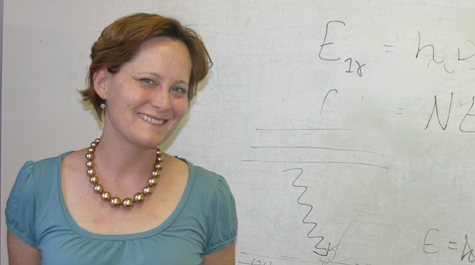Tracking the elusive ghost particle
“Imagine if you shot a stream of neutrinos through a brick of lead one light year thick,” Patricia Vahle said. “More than half of them would come out of the other side.”
Vahle is an assistant professor in the physics department at William & Mary. She is one of a group of researchers participating in NOvA, an experiment that will bring about a greater understanding of the neutrino—and of the universe itself.
Neutrinos are important to physicists because their properties hold the key to understanding a number of questions, such as a fuller understanding of nuclear fusion and fission mechanics and the mystery of why antimatter is so rare in the universe.
“If you want to understand how the universe began and how it evolved and how it is working today, you need to understand as much as you can about the neutrino,” she said.
Neutrinos are difficult to study, but it’s not because they are scarce: In the time you took to read this sentence, an enormous number have passed through your body.
“The neutrino is among the most common and abundant particles in the universe,” Vahle explained. “They’re difficult to study because they don’t interact very much. In order to study a neutrino, you have to make it interact with matter so you can see what comes out.”
The NOvA experiment is designed to make those neutrino-matter interactions happen. NOvA is short for the NuMI Off-Axis Electron Neutrino Appearance facility, an experiment based at the U.S. Department of Energy’s Fermi National Accelerator Laboratory outside Chicago. The initiative will send streams of neutrinos 500 miles through the earth from the Fermilab facility to the NOvA detector in Minnesota. A ground-breaking ceremony is scheduled for May 1 at the northern Minnesota detector site, a laboratory of the University of Minnesota’s School of Physics and Astronomy.
The neutrinos generated at Fermilab will make their 500-mile trip in less than three milliseconds. On their way to Minnesota, the neutrinos will be counted at a Fermilab detector. Neutrinos come in three “flavors,” Vahle explained: electron, muon and tau. A predecessor experiment to NOvA, known as MINOS, used a similar scenario to verify that the neutrinos were oscillating—or changing flavors. A better understanding of neutrino oscillation will yield a better understanding of neutrino mass, she said.
“We make a beam of muon-type neutrinos and what we found in MINOS is that some of those neutrinos just go away,” Vahle said. “We can’t tell what they’re going into. They can either go into tau-type neutrinos or they can change into electron-type neutrinos.”
NOvA is designed to identify just how the neutrinos are oscillating. “We think that the mode of oscillation is that these muon neutrinos turn into tau neutrinos,” she said. “But there is room for these muon-type neutrinos to turn into electron-type neutrinos.”
Vahle’s part in the project is to lead a team responsible for the calibration of the detectors, which she said are to be larger and more sensitive than those used for MINOS. Basically, she said, the detectors will be an array of PVC pipe filled with a fluid that is largely mineral oil. Calibration of the detector is essential.
“It doesn’t sound very sexy, but it’s a fundamental step that you have to do in order to understand what you’re seeing when a neutrino interacts in your detector,“ she said. “What happens is this: The neutrino comes in, it gets close to a nucleus in the detector and it will interact with that nucleus. It’s going to spit out a shower of daughter particles that form in that interaction.”
She explained that NOvA scientists will measure the energy of each daughter particle and add them up to determine the energy that the neutrino had to begin with.
“In order to figure out how much energy each one of those daughter particles have, you need some reference to compare it to, some sort of ‘standard candle,’” she said. “That’s not something you can figure out from basic principles. It’s something you need to measure in your detector. So, I’m leading the group that figures out what that ‘standard candle’ is and what sort of process we need to go through to figure out what the energy of the neutrino was in the first place.”
Vahle is one of some 180 scientists and engineers from 28 institutions in seven countries participating in NOvA. While the detector is being constructed, Vahle will explore calibration calculations from her office in Small Hall, working with Alena Gavrilenko, a Ph.D. student in physics.
The DOE Office of Science has provided $40.1 million in Recovery Act funding for the construction project. It will provide an additional $9.9 million in Recovery Act funding to Fermilab, which will manage the project.
 Skip to main content
Skip to main content

